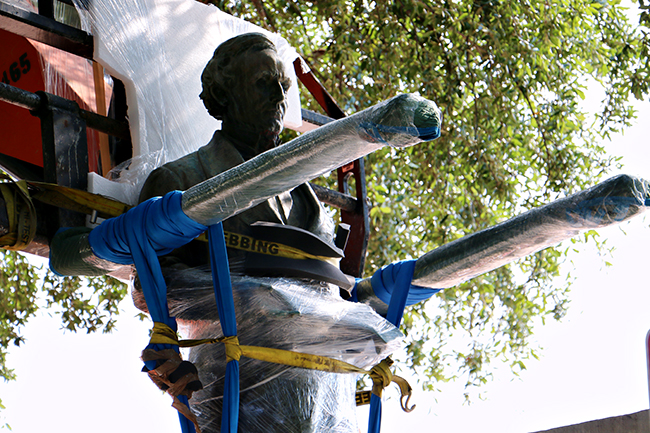Decades of stifled objections and half a year of heated debate ended mundanely on a quiet Sunday morning, when a forklift carried the cellophane-wrapped Jefferson Davis statue from its central position on UT’s Main Mall. It will be relocated to a more appropriate place of exhibition in the Briscoe Center for American History.
The dedication and resilience of student activists is what separated this movement to remove Davis from those which came before. But that burden should not be placed solely on a small and marginalized community. Instead, its triumph should inspire the entire student body to continue pursuing meaningful change.
A long period of student apathy prolonged what should have been a clear-cut decision. We wrote last week about the administrative complacency that prevented the statue from being removed before the start of the school year. But despite intense media scrutiny and a student government outspokenly in support of the movement, public interest in the issue rarely manifested itself as more than the occasional protest message spray-painted over the statue’s base. An overwhelming majority of UT students did not voice any objections to the statue’s presence, either extemporaneously or at any of the public forums designated for debate over the issue.
That apathetic majority of the University’s students might, at least from afar, sympathize with a movement to remove a symbol of white supremacy and racial hatred. But there’s little value in silent support for an individual’s or a group’s struggle for justice. Active allyship is often what helps push social movements into the consciousness of the general public and onto the agendas of influential voices and policymakers. If it weren’t for student leadership and activism, it’s unlikely that the decades-long controversy surrounding Davis would have emerged to the forefront of campus political discourse.
And yet, the movement’s eventual success reflects the extraordinary power that just a small fraction of a 51,000-strong student body has to affect tangible social change. That — not restraining orders or lethargic committees or #BumpTheChump — is the most significant lesson of the statue ordeal. Its conclusion does not represent the end of adversity and inequity on campus, but it can represent the beginning of a new era in student activism, where those most affected by injustices are empowered by a network of supporters and allies, and students are encouraged to unify in pursuit of worthwhile reforms.
UT’s student body can achieve great things with that empowered mentality in mind. We urge that it not leave campus as quietly as Davis did yesterday morning.
















